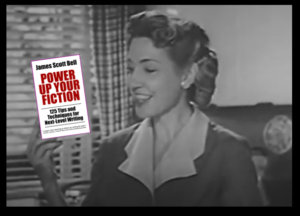by James Scott Bell
@jamesscottbell
Today’s post is brought to you by that new craft book, Power Up Your Fiction: 125 Tips and Techniques for Next-Level Writing. Yes, you too can write fiction that has the extras readers crave. Removes those ugly speed bumps, too. Don’t be the last one in your critique group to own a copy. Get yours today at a special price! And now here’s your host, JSB…
Brought to you by…
In the early years of television, most shows had a single sponsor paying the bills, e.g., Colgate Comedy Hour, Texaco Star Theatre, Goodyear TV Playhouse, Kraft Television Theatre. The shows that were “brought to you by” often featured the stars in a commercial.
“Father Knows Best, brought to you by Maxwell House Coffee. Good to the last drop.”
“Leave it to Beaver has been brought to you by Ralston Purina, makers of the eager eater dog food.”
“The Fugitive has been brought to you by Viceroy cigarettes. Viceroy’s got the taste that’s right.”
Speaking of that ubiquitous weed, a plethora of shows were sponsored by tobacco companies. Everybody smoked back then, even cartoon characters:
Even the pious:
Consistent quality was the key
The sponsors hoped the brand would be associated with a quality show and its stars, week after week. Not just quality, but consistent quality, directed to a target audience.
The most popular show of 1953 was I Love Lucy. It worked because Lucille Ball was a brilliant comedic actress, Desi Arnaz a perfect foil and also an astute producer who worked with a great team of writers.
The second most popular show that year was Dragnet, about as polar an opposite of Lucy as you could find. A police drama, it had a consistent style developed by its star, Jack Webb. That style featured staccato dialogue and underplayed acting. It became famous and easily parodied. Fortunately, Jack Webb had a sense of humor about it:
What if you want to write something “off brand”? In the traditional publishing world, this is problematic for obvious commercial reasons. You’re building an audience and helping bookstores know where to shelve your books. Publishers are investing in you, hoping for a long-term relationship that is profitable for all.
This is what hamstrung early John Grisham, whose massively popular legal thrillers made the big bucks. But Grisham wanted to write literary fiction, too. It was only when he had sufficient leverage that his publisher came out with A Painted House.
Indie writers have more flexibility, though they also want to build a brand. But we have short stories and novellas to try things out, and can publish them instantly. The old ad man saying applies here: “Let’s run it up the flagpole and see if anybody salutes.”
So…build your brand with consistent quality. Meet reader expectations in your genre, but also exceed them by adding unique and memorable touches. Everybody remembers Lucy and Ethel stuffing candy into their mouths, hats and down their uniforms.
Remember famed writer/director John Huston’s axiom: a great movie is made up of “three great scenes, and no weak ones.”
Which also means don’t flood the market with less than your best. For as another movie legend used to say:

